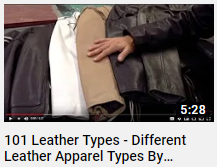Leather Types - Jamin Leather®
![]() Facebook
Facebook![]() Twitter
Twitter![]() Instagram
Instagram![]() Bike Week
Bike Week![]() Pinterest
Pinterest
Highway 17 Bypass, Myrtle Beach SC 29577
Superstore Location 1222 - 1220 Port Dr, Myrtle Beach SC 29577
Superstore Hours Mon-Sat 10 am to 6 pm, Sunday 12 pm to 5 pm
Contact Us - Opportunities - Leather Care - Leather Repair
Jamin Leather Video Series Highlights
Buy with Confidence - Understanding Leather Types and Properties
What is the best leather for MOTORCYCLE APPAREL?
Here is a down and dirty shortcut and quick reference from cheapest to best leathers for motorcycle apparel:
POOR:Sheepskin - Lambskin - Patch Leather - Pigskin - Suedes
FAIR: Split Buffalo - Split Cowhide
GOOD: Top Grain Goatskin - Top Grain Buffalo - Top Grain Cowhide - Top Grain Horsehide
PREFERRED:Top Grain Premium Buffalo - Top Grain Premium Cowhide - Top Grain Naked Buffalo - Top Grain Naked Cowhide
To get the most bang for your buck Jamin' Leather recommends any of the top grain cowhides or buffalo leathers for protection for riding or motorcycle purposes. As you will see below we have several leather types that are not shown above. This is simple because, either some are not available in leather apparel and some are some fall into another category of leather types and used mainly for other reasons, other than motorcycle apparel. Read on...
DESCRIPTION OF LEATHER TYPES
Top Grain Pigskin - Economically priced leather, noticeable hair follicle pattern, thin leather generally .8-1.0 mm thick.
Top Grain Cowhide - Maximum valued material for texture and appearance, top grain finish, extremely durable, firm yet easy to break in, comfortable, thickness vary greatly from .8 mm thick to 1/8" thick for belting and saddlery, grain can be from extra smooth through a pebble grain uniform pattern, generally less expensive grains will have some spider web type gain pattern.
Top Grain Goatskin - Economically priced leather more durable than pigskin but with a courser tiny pebble grain finish. Generally only available in weights of .9 to 1.1 mm thick.
Top Grain Horsehide - Can be expensive but lately has been pricing similar to cowhide but happens to be harder to work with, stiffer and stronger. Ideal for bag and cases or heavy biker garments. Harder to find these days. Thicknesses from 1.0 to 1/8" thick.
Top Grain Calfskin - Rare in comparison to other leathers, baby cow, more durable than cow, thin, softer, thickness range from .8 mm to 2.0 mm thickness.
Top Grain Buffalo - Value priced, heavy duty leather, hair follicles and grain often evident, durable and generally found in thickness from .9 mm to 3.0 mm thick.
Top Grain Steerhide - A skin from a male cow or male buffalo that is generally the same properties of each but a bit tougher than the female skins.
Top Grain Sheepskin/Lambskin - Extremely soft, comfortable, pliable but can stretch and excessively distort the shape of the garment after excessive use, some tanning can be expensive, softer and plumper is more expensive, less expensive skins have a tight small pebble grain and the cheapest skins will be course in it's feel.
Top Grain Deerskin - Most value in softness vs durability, extremely soft and extremely durable, generally very expensive. Pebble grain common. Soft touch and somewhat spongy in it's feel. Thickness is between 1.0 and 3.0 mm thick.
Top Grain Naked Leather - This is a tanning process or lack of finishes giving it the Naked name. Any skin can be naked but most commonly you will find naked leathers in cowhide with all the durability and qualities of such. Generally a more expensive skin because they have to use choice skins (without markings and scars) for the leather to be used in manufacturing without waste.
Top Grain Distressed Buffalo - A term used commonly these days as an uneven colored finish. Most common in light brown naked buffalo leather (where each panel on a garment is rarely a perfect match due to the unique qualities of each and every skin). In the 50's though the 80's, distressed leathers had been where the painted outer coat finish came off or rubbed off during use. Some people still use words like "rub off" or "pull up" (pull up has extra oils in it for a similar effect). Distressed can come in a variety of thicknesses, textures, skins and even colors.
Split Cowhide/Buffalo Leather - Economically priced leather that can appear like top grain finish or a rustic cracked finish leather. strong and durable and can vary in thickness from .8 mm thick thru 1/8" thick.
Cow Suede - Suede is a split leather. Maximum durability in a suede, comfortable, can come is a variety of softness, thickness can vary greatly from .8 mm thick thru 1/8" thick.
Pig Suede - Suede is a split leather. Economically priced suede, noticeable hair follicle pattern, very soft, thin suede generally .8-1.0 mm thick.
Chamois - Is baby lambskin and generally a split sueded skin. Absorbent and naturally yellow in color. This is the split section of the hide. Can be used in washable garments, stains easily, extremely soft to the touch and my dry stiff unless hung neatly to dry. Thickness is from .8 to 1.2 mm thick.
Patch Leather - Random scraps of leather are sewn together and then pressed to make a large flat garment later cut into pattern parts to make things from jackets to bags. Generally any type of leather is used here. Most common is garment weights of .9 to 1.0 mm thick in a variety of pigskins, lambskins, goatskins, sheepskins and even cowhide.
See All Our YouTube Instruction Videos
10/7/22 YouTube Video
______________________________________
1/6/23 YouTube Video
______________________________________



